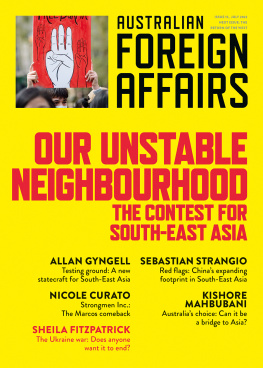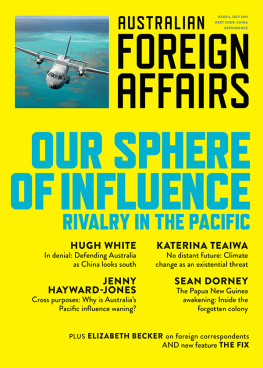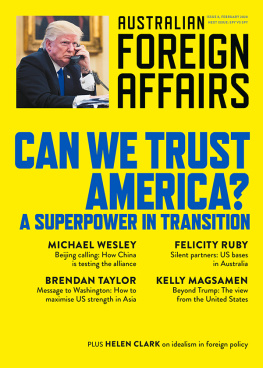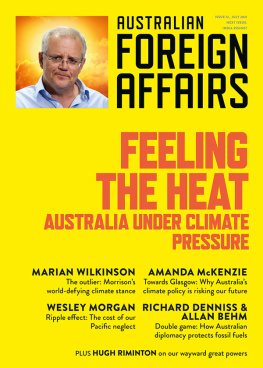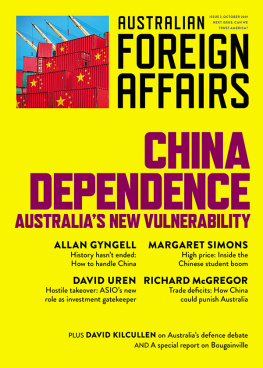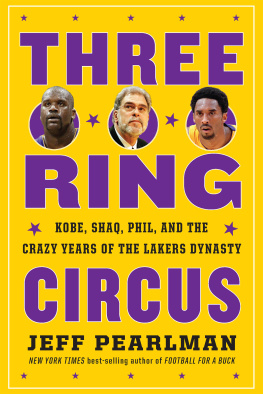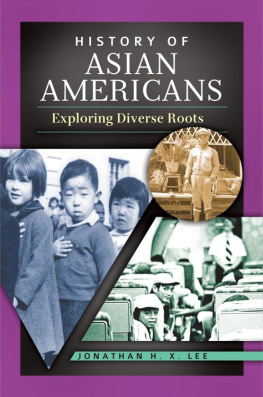ISSUE 5, FEBRUARY 2019
AUSTRALIAN FOREIGN AFFAIRS
Australian Foreign Affairs is published three times a year by Schwartz Publishing Pty Ltd. Publisher: Morry Schwartz. ISBN 978-1-74382-0735 ISSN 2208-5912 ALL RIGHTS RESERVED. No part of this publication may be reproduced, stored in a retrieval system, or transmitted in any form by any means, electronic, mechanical, photocopying, recording or otherwise, without the prior consent of the publishers. Essays, reviews and correspondence retained by the authors. Subscriptions 1 year print & digital auto-renew (3 issues): $49.99 within Australia incl. GST. 1 year print and digital subscription (3 issues): $59.99 within Australia incl. GST. 2 year print & digital (6 issues): $114.99 within Australia incl. GST. 1 year digital only auto-renew: $29.99. Payment may be made by MasterCard, Visa or Amex, or by cheque made out to Schwartz Publishing Pty Ltd. Payment includes postage and handling. To subscribe, fill out the form inside this issue, subscribe online at www.australianforeignaffairs.com, email subscribe@australianforeignaffairs.com or phone 1800 077 514 / 61 3 9486 0288. Correspondence should be addressed to: The Editor, Australian Foreign Affairs, Level 1, 221 Drummond Street, Carlton VIC 3053 Australia Phone: 61 3 9486 0288 Email: enquiries@australianforeignaffairs.com Editor: Jonathan Pearlman. Associate Editor: Chris Feik. Consulting Editor: Allan Gyngell. Deputy Editor: Julia Carlomagno. Editorial intern: Ebony Young. Management: Caitlin Yates. Marketing: Elisabeth Young, Georgia Mill and Iryna Byelyayeva. Publicity: Anna Lensky. Design: Peter Long. Production Coordination: Marilyn de Castro. Typesetting: Akiko Chan. Cover photo of Scott Morrison and international world leaders Dita Alangkara/AAP. Printed in Australia by McPhersons Printing Group.
Contributors
Aarti Betigeri is a journalist who writes regularly on South Asian issues.
Santilla Chingaipe is a journalist who has reported on Africa and Australias African communities.
Peter Fray is co-director of the Centre for Media Transition at University Technology Sydney and founder of PolitiFact Australia.
Sam Geall is executive editor at China Dialogue and associate fellow at Chatham House, a think tank in London.
Linda Jaivin is a novelist, essayist, translator and cultural commentator with a long-standing interest in China.
George Megalogenis is a journalist, political commentator and author.
Sam Roggeveen is director of the International Security Program at the Lowy Institute and founding editor of The Interpreter website.
Sarah Teo is an associate research fellow at the S. Rajaratnam School of International Studies in Singapore.
Christos Tsiolkas is a novelist, playwright and essayist.
David Walker is a historian and emeritus professor at Deakin University whose latest book is Stranded Nation: White Australia in an Asian Region.
Editors Note
ARE WE ASIAN YET?
W hen the debate about Australias place in Asia last flared, in the 1990s, John Howard famously declared that Australia did not have to choose between our history and our geography.
He was right. Australia is the product of its history its unreconciled relationship with its first peoples, its British past, its turn towards the United States and its geography, as a continent at the southern edge of Asia. These two forces shape the nation and they leave it with very few choices.
The extent to which Australia is Asian or Western is a question, rather than a choice. But answering it, and describing the nations evolving identity, is not equivalent to, as Howard claimed, disowning the past. Instead, it is an inquiry that reveals much about Australias character, outlook, and place and reputation in the region and the world.
In the twenty-four years since Howards declaration, changes in Australia all appear to be tilting it away from the West and towards Asia. Today, Asian countries account for eleven of Australias top fifteen trading partners, and at least 56 per cent of Australias migrant intake. Canberras diplomatic and defence ties across the region have deepened, and Australia is increasingly accepted as a participant of regional groupings such as the East Asian Summit or, from 2022, the Asian Games.
Clearly, the benefits that Australia receives from its geography are increasing. But the benefits from its history appear to be shrinking. Australias Western heritage led it to align with the two great powers of the previous two centuries, first Britain and then the United States. Now the regional balance is changing, and the United States relative power in Asia is in decline. For Australia, being a Western outpost in Asia will soon lose its allure. The emphasis will no longer fall on Western but on outpost.
Yet much of Australias cultural and political life and global outlook stem from Western institutions. And its growing reach into the region is often transactional, which may limit the extent of its engagement. Australia may find its prosperity and security in Asia, but its people, politics, location and economy will mix in ways that are impossible to predict.
As Australia tries to make the most of the Asian Century, its place in Asia is likely to remain an open question.
Jonathan Pearlman
SIGNIFICANT OTHER
Anxieties about
Australias Asian future
David Walker
In 1968, the University of New South Wales (UNSW) chose the topic Australia: A Part of Asia? for its annual symposium. The universitys professor of history, Frank Crowley, initially knocked back the invitation to speak, declaring in no uncertain terms that Australia never had been and never would be part of Asia. When prevailed upon to take part, he maintained that Australia was an outpost of Europe. While he saw value in Asian studies, he did not think Australia should move closer to Asia politically or liberalise its immigration policy. All speakers at the symposium stressed the importance of Australias European heritage. None considered Australia part of Asia.
In 1992, Prime Minister Paul Keating delivered an address, Australia and Asia: Knowing Who We Are, in which he referenced Robert Menzies early speeches celebrating Australias place in the British Empire. In the 1930s, wool exports to Japan had grown, speeding Australias recovery from the Great Depression and encouraging speculation that the nations economic future lay in Asia. Despite such opportunities, Menzies insisted that Australians would always put their blood ties with Britain before commerce. In contrast, Keating wanted to establish Australias rightful presence in the Asia-Pacific. He was concerned that the ghost of Empire, faded and diminished as it had become, still stood in the way of the cultural changes needed to promote Asian engagement. He insisted that if Australia did not succeed in forging ties in Asia, it would not succeed anywhere.
For Julie Bishop, Minister for Foreign Affairs and Trade in the Coalition government until August 2018, the New Colombo Plan became a personal enthusiasm and a key to Asian engagement. She often alluded to the proud antecedents of this scheme, a reminder that Coalition governments had taken Australias place in Asia seriously. The original Colombo Plan had been a great success for Percy Spender, Menzies Minister for External Affairs. In discussing the New Colombo Plan, Bishop kept her language pragmatic and emphasised economic diplomacy. Australias national interest was best served, Bishop maintained, by encouraging Asian prosperity.
In this protracted discussion of identity and place, the ground is constantly shifting.




